-
 [Untitled]
[Untitled] Rifle, Short, Magazine, Lee Enfield, .303 inch, Mk 3
-
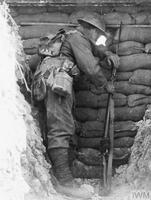 [Untitled]
[Untitled] Sentry of the Worcestershire Regiment looking through a loop-hole in a trench at Ovillers, August 1916.
-
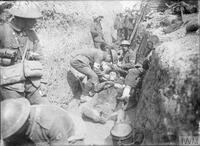 [Untitled]
[Untitled] Wounded men of the 1st Battalion, Lancashire Fusiliers, being tended in a trench in the 29th Division's area near Beaumont Hamel on the morning of the initial assault, 1st July 1916.
-
 [Untitled]
[Untitled] A heavy shell bursting during the Battle of the Somme.
-
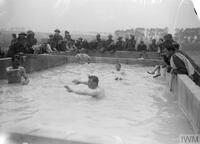 [Untitled]
[Untitled] British troops bathing near Aveluy, 7 August 1916.
-
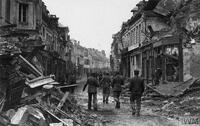 [Untitled]
[Untitled] German troops in shell ruined Peronne, 1916.
-
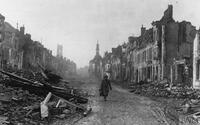 [Untitled]
[Untitled] Lone German soldier in shell ruined and deserted Peronne, 1916.
-
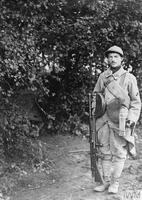 [Untitled]
[Untitled] A French gunner of the 53rd Infantry Regiment (Tenth Army) with his Chauchat machine gun in the Somme area, 25 August 1916.
-
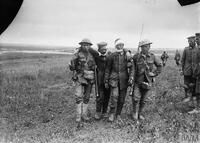 [Untitled]
[Untitled] Battle of Albert. British soldiers with wounded German prisoners. La Boisselle, 3rd July 1916.
-
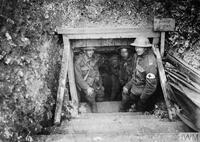 [Untitled]
[Untitled] Battle of Albert. British troops in the entrance to a German dugout in the Dantzig alley trench in Fricourt. Fricourt was abandoned by the Germans during the night of 1 - 2 July.
-
 [Untitled]
[Untitled] The Battle of Thiepval. A dead German soldier.
-
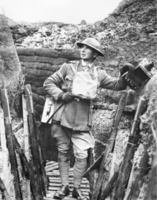 [Untitled]
[Untitled] France: Lieut. Ernest Brooks, official photographer on the Western Front
-
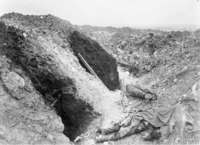 [Untitled]
[Untitled] The bodies of two German soldiers lie in a trench badly damaged by artillery fire.
-
 [Untitled]
[Untitled] The Vickers .303 inch Class C was a commercially-available, water-cooled machine gun which was trialled by the British Army from 1910. Following a few changes, it was adopted by the British Army as the Vickers Mark 1 on 26th November 1912 and became the standard machine gun of the British and Commonwealth forces. It weighs about 28 lbs when empty of water and typically required a six to eight-man team to transport and operate them and their associated accessories and ammunition.
-
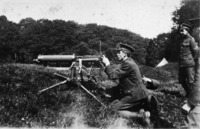 [Untitled]
[Untitled] Members of No.1 Section, 131st Machine Gun Company, receiving training on the Vickers machine gun at Belton Park Camp, Grantham, Lincolnshire in 1915.
-
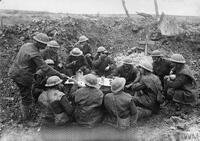 [Untitled]
[Untitled] British troops eating their Christmas dinner in a shell hole, Beaumont Hamel, 25th December 1916.
-
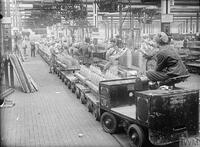 [Untitled]
[Untitled] A woman drives a trolley train across a busy factory floor at the National Filling Factory, Chilwell. The trolley is loaded with shells and is used to transport the shells from one part of the factory to another. Around 21 August, 1917.
-
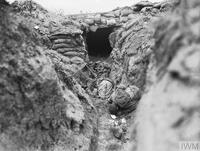 [Untitled]
[Untitled] Albert 1 - 13 July: Two German dead in a front line trench.
-
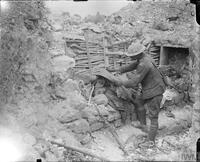 [Untitled]
[Untitled] Capture of Ovillers. British soldier covering up with a coat a dead German soldier, lying on the firestep of a trench.
-
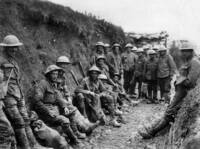 [Untitled]
[Untitled] Men of the Royal Irish Rifles resting in a communication trench during the opening hours of the Battle of the Somme, July 1, 1916
-
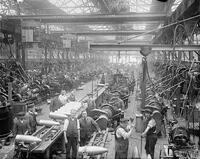 [Untitled]
[Untitled] Interior of a British shell factory during the First World War.
-
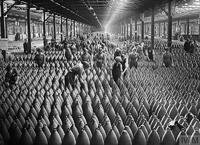 [Untitled]
[Untitled] Munition workers in a shell warehouse at the National Shell Filling Factory, Chilwell, Nottinghamshire. This was one of the largest shell factories in the country. Around 21 August, 1917.
-
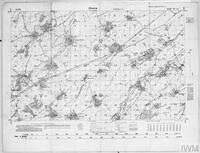 Map of France, Sheet 51c SE
Map of France, Sheet 51c SE
-
 [Untitled]
[Untitled] John Warwick Brooke, the official photographer, followed them in the sap, into which a shell fell short killing seven men.
 [Untitled] Rifle, Short, Magazine, Lee Enfield, .303 inch, Mk 3
[Untitled] Rifle, Short, Magazine, Lee Enfield, .303 inch, Mk 3 [Untitled] Sentry of the Worcestershire Regiment looking through a loop-hole in a trench at Ovillers, August 1916.
[Untitled] Sentry of the Worcestershire Regiment looking through a loop-hole in a trench at Ovillers, August 1916. [Untitled] Wounded men of the 1st Battalion, Lancashire Fusiliers, being tended in a trench in the 29th Division's area near Beaumont Hamel on the morning of the initial assault, 1st July 1916.
[Untitled] Wounded men of the 1st Battalion, Lancashire Fusiliers, being tended in a trench in the 29th Division's area near Beaumont Hamel on the morning of the initial assault, 1st July 1916. [Untitled] A heavy shell bursting during the Battle of the Somme.
[Untitled] A heavy shell bursting during the Battle of the Somme. [Untitled] British troops bathing near Aveluy, 7 August 1916.
[Untitled] British troops bathing near Aveluy, 7 August 1916. [Untitled] German troops in shell ruined Peronne, 1916.
[Untitled] German troops in shell ruined Peronne, 1916. [Untitled] Lone German soldier in shell ruined and deserted Peronne, 1916.
[Untitled] Lone German soldier in shell ruined and deserted Peronne, 1916. [Untitled] A French gunner of the 53rd Infantry Regiment (Tenth Army) with his Chauchat machine gun in the Somme area, 25 August 1916.
[Untitled] A French gunner of the 53rd Infantry Regiment (Tenth Army) with his Chauchat machine gun in the Somme area, 25 August 1916. [Untitled] Battle of Albert. British soldiers with wounded German prisoners. La Boisselle, 3rd July 1916.
[Untitled] Battle of Albert. British soldiers with wounded German prisoners. La Boisselle, 3rd July 1916. [Untitled] Battle of Albert. British troops in the entrance to a German dugout in the Dantzig alley trench in Fricourt. Fricourt was abandoned by the Germans during the night of 1 - 2 July.
[Untitled] Battle of Albert. British troops in the entrance to a German dugout in the Dantzig alley trench in Fricourt. Fricourt was abandoned by the Germans during the night of 1 - 2 July. [Untitled] The Battle of Thiepval. A dead German soldier.
[Untitled] The Battle of Thiepval. A dead German soldier. [Untitled] France: Lieut. Ernest Brooks, official photographer on the Western Front
[Untitled] France: Lieut. Ernest Brooks, official photographer on the Western Front [Untitled] The bodies of two German soldiers lie in a trench badly damaged by artillery fire.
[Untitled] The bodies of two German soldiers lie in a trench badly damaged by artillery fire. [Untitled] The Vickers .303 inch Class C was a commercially-available, water-cooled machine gun which was trialled by the British Army from 1910. Following a few changes, it was adopted by the British Army as the Vickers Mark 1 on 26th November 1912 and became the standard machine gun of the British and Commonwealth forces. It weighs about 28 lbs when empty of water and typically required a six to eight-man team to transport and operate them and their associated accessories and ammunition.
[Untitled] The Vickers .303 inch Class C was a commercially-available, water-cooled machine gun which was trialled by the British Army from 1910. Following a few changes, it was adopted by the British Army as the Vickers Mark 1 on 26th November 1912 and became the standard machine gun of the British and Commonwealth forces. It weighs about 28 lbs when empty of water and typically required a six to eight-man team to transport and operate them and their associated accessories and ammunition. [Untitled] Members of No.1 Section, 131st Machine Gun Company, receiving training on the Vickers machine gun at Belton Park Camp, Grantham, Lincolnshire in 1915.
[Untitled] Members of No.1 Section, 131st Machine Gun Company, receiving training on the Vickers machine gun at Belton Park Camp, Grantham, Lincolnshire in 1915. [Untitled] British troops eating their Christmas dinner in a shell hole, Beaumont Hamel, 25th December 1916.
[Untitled] British troops eating their Christmas dinner in a shell hole, Beaumont Hamel, 25th December 1916. [Untitled] A woman drives a trolley train across a busy factory floor at the National Filling Factory, Chilwell. The trolley is loaded with shells and is used to transport the shells from one part of the factory to another. Around 21 August, 1917.
[Untitled] A woman drives a trolley train across a busy factory floor at the National Filling Factory, Chilwell. The trolley is loaded with shells and is used to transport the shells from one part of the factory to another. Around 21 August, 1917. [Untitled] Albert 1 - 13 July: Two German dead in a front line trench.
[Untitled] Albert 1 - 13 July: Two German dead in a front line trench. [Untitled] Capture of Ovillers. British soldier covering up with a coat a dead German soldier, lying on the firestep of a trench.
[Untitled] Capture of Ovillers. British soldier covering up with a coat a dead German soldier, lying on the firestep of a trench. [Untitled] Men of the Royal Irish Rifles resting in a communication trench during the opening hours of the Battle of the Somme, July 1, 1916
[Untitled] Men of the Royal Irish Rifles resting in a communication trench during the opening hours of the Battle of the Somme, July 1, 1916 [Untitled] Interior of a British shell factory during the First World War.
[Untitled] Interior of a British shell factory during the First World War. [Untitled] Munition workers in a shell warehouse at the National Shell Filling Factory, Chilwell, Nottinghamshire. This was one of the largest shell factories in the country. Around 21 August, 1917.
[Untitled] Munition workers in a shell warehouse at the National Shell Filling Factory, Chilwell, Nottinghamshire. This was one of the largest shell factories in the country. Around 21 August, 1917. Map of France, Sheet 51c SE
Map of France, Sheet 51c SE
 [Untitled] John Warwick Brooke, the official photographer, followed them in the sap, into which a shell fell short killing seven men.
[Untitled] John Warwick Brooke, the official photographer, followed them in the sap, into which a shell fell short killing seven men.